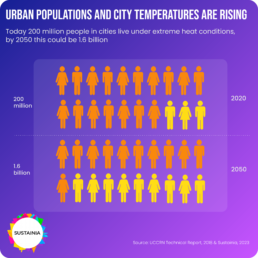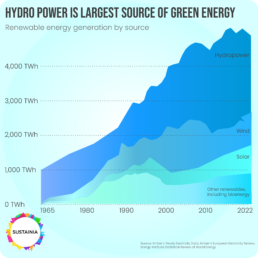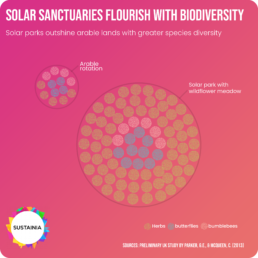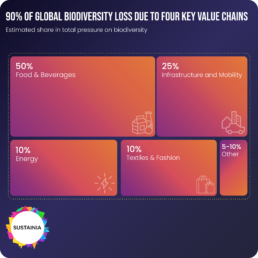Sustainia Simplifies
Avoid, shift, improve

Meet the Avoid, Shift, Improve framework: City life all the way to 2050
In the era of global sustainability goals, climate accords, and international conventions, urban areas stand at the forefront of the battle for a sustainable future. With burgeoning populations, rising temperatures, and the urgent need to meet climate targets, the imperative for transformative action is resounding. In this brief, we delve into the intricate web of urban sustainability challenges, focusing on food consumption, heat mitigation, population growth, and congestion. We introduce the “Avoid, Shift, Improve” (ASI) framework, inspired by the findings of the Intergovernmental Panel on Climate Change’s (IPCC) 2022 sixth Assessment report, as a pragmatic solution for cities worldwide.
Our urban predicament
Urbanization has become an unstoppable global force, with over half of humanity now dwelling in cities. However, this rapid urban expansion has spawned the Urban Heat Island (UHI) effect, propelling city temperatures to alarming levels. Escalating temperatures strain energy resources and pose grave health threats to urban residents, placing a bright spotlight on UN Sustainable Development Goal (SDG) 11 (Sustainable Cities and Communities) and SDG 13 (Climate Action).
Additionally, the food sector looms large as a significant contributor to global greenhouse gas emissions, responsible for roughly 30% of the total. As urban populations surge, the demand for food skyrockets, intensifying scrutiny on urban diets and their carbon footprint. This presents a formidable challenge to SDG 2 (Zero Hunger) and SDG 12 (Responsible Consumption and Production).
The ASI imperative
1. Avoid: Cities must wage a relentless battle against food waste. Innovative solutions, such as community composting programs, surplus food redistribution networks, and incentives for businesses to curb food waste, have yielded remarkable results. Seattle’s Food Waste Program, for example, has diverted over 125,000 tons of food from landfills.
2. Shift: Individual choices wield substantial influence. Encouraging citizens to opt for plant-based diets and reduce meat consumption is of paramount importance. Cities can take the lead with initiatives and campaigns that emphasize robust support for urban agriculture. Ghent, Belgium, has embraced “Veggie Day” to effectively reduce meat consumption.
3. Improve: Efficiency is key to combating the UHI effect in the food sector. For example, as part of Barcelona’s 2030 sustainable food system target, the city promotes environmentally friendly, low-carbon and energy-efficient food production.
The odyssey to net-zero by 2050
The IPCC’s resounding call to halve emissions by 2030, keeping heating to below 1.5 degrees Celsius with the aim of reaching net-zero by 2050 is a stark reminder of the urgency we face, closely aligning with the goals of the Paris Agreement. Cities must set bold targets in alignment with these climate imperatives and craft comprehensive climate action blueprints that address multiple fronts, including:
1. Food Emissions: Promote local and sustainable food production to slash emissions. Initiatives like British Columbia, Canada’s “Farm to School” programs connect students with locally grown produce, reducing emissions from long-distance food transport.
2. Heat Mitigation: Urban spaces must undergo a green transformation. Paris, France, plans to add hectares of green roofs, walls, and vegetation by 2030 to counteract rising temperatures.
3. Overpopulation and Congestion: Implement policies that alleviate congestion, a pivotal element in achieving SDG 11. Barcelona, Spain, has successfully encouraged walking and cycling by expanding pedestrian zones and bike lanes, reducing traffic congestion and emissions.
Conclusion
In the race to secure a sustainable urban future, the ASI framework emerges as a guiding compass. As cities grapple with surging populations, soaring temperatures, and food-related emissions, they must wholeheartedly embrace transformative approaches such as this. By combating food waste, promoting plant-based diets, and enhancing urban infrastructure, cities can propel themselves toward a net-zero emissions future – and with planning and careful execution cities can continue to be joyful places to live.



